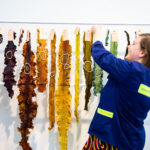Partnering with Nature

about the exhibition
On view at the World Economic Forum’s 50th Annual Meeting, Jan. 21 through Jan. 24 in Davos-Klosters, Switzerland.
Drawing from the Nature—Cooper Hewitt Design Triennial exhibition originally organized by Cooper Hewitt and Cube design museum, this adaptation is a collaboration between the Smithsonian and the World Economic Forum (WEF). This is the fourth year that the Smithsonian and the WEF have collaborated on bringing an exhibition to the Annual Meeting in Davos. Installed in the Congress Centre, the exhibition will be offered alongside panels, workshops, and other sessions organized by the WEF that address the ecological crisis and the Forum’s major focus on sustainability.
Four installations will encourage participants to play with natural elements, learn about the symbiotic relationships in nature, and be inspired to imagine a more cohesive approach to working with nature.
Exhibition
WATCH NOW

About the Works On View
Department of Seaweed Prototyping Workshop, 2019–20
Founded by Julia Lohmann in 2013, the Department of Seaweed brings together experts in design, science and craft to experiment with the fabrication processes and material properties of seaweed and explore possible applications of this plentiful and renewable resource. For the installation at Davos, Lohmann will create a seaweed structure, Hidaka-Ohmu, and have available living seaweed and a display of hanging, dried seaweed to show the materials used in the craft process. Participants will work with seaweed in a workshop with Lohmann’s team.
Tree of 40 Fruit, 2008–ongoing
Artist Sam Van Aken collapses an orchard of fruit trees into a single tree using centuries-old grafting techniques. Van Aken worked with Fructus, the Swiss Association for the Protection of Fruit Heritage, to identify, collect and graft 40 apple varieties onto a 6-year-old tree. The varieties originated, are historically grown, or are important commercial varieties in Switzerland. Van Aken maps the tree grafts with hand-drawn sketches that are color-coded to each blossom’s season. Participants will be invited to try bench grafting—a technique where scionwood is grafted to root systems to create new trees.
Totomoxtle, 2017–ongoing
Totomoxtle means “corn husk” in the Nahuatl language and refers to the brilliantly colored veneers made from native Mexican corn by designer Fernando Laposse. Since 2017, Laposse has collaborated with farmers, agronomists and scientists to reintroduce native varieties of corn that were decimated by industrial farming. The initiative has led to local job growth, a resurgence of craft and food traditions, and restoration of indigenous farming practices. Participants will join in the completion of a mosaic.
Algae Platform, 2019–20
Developed by Atelier Luma, a think-tank, workshop and space for research, production and learning, the Algae Platform investigates the potential of algae as an alternative material to plastic with many possible applications in the architecture and design field. Algae is a globally renewable resource that is found in natural, urban and industrial landscapes, and can be 3-D printed into vessels and extruded into filaments for textiles.
Featured Image: Impressions from the World Economic Forum Annual Meeting 2020 in Davos-Klosters, Switzerland, 19 January. Copyright by World Economic Forum/Sikarin Fon Thanachaiary





